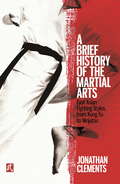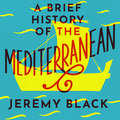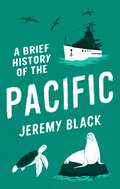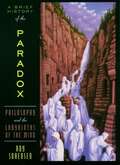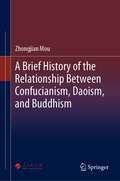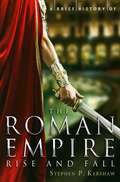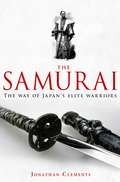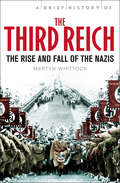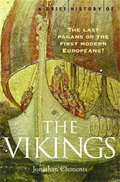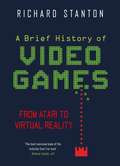- Table View
- List View
A Brief History of the Late Ottoman Empire
by M. Şükrü HanioğluAt the turn of the nineteenth century, the Ottoman Empire straddled three continents and encompassed extraordinary ethnic and cultural diversity among the estimated thirty million people living within its borders. It was perhaps the most cosmopolitan state in the world--and possibly the most volatile. A Brief History of the Late Ottoman Empire now gives scholars and general readers a concise history of the late empire between 1789 and 1918, turbulent years marked by incredible social change. Moving past standard treatments of the subject, M. Sükrü Hanioglu emphasizes broad historical trends and processes more than single events. He examines the imperial struggle to centralize amid powerful opposition from local rulers, nationalist and other groups, and foreign powers. He looks closely at the socioeconomic changes this struggle wrought and addresses the Ottoman response to the challenges of modernity. Hanioglu shows how this history is not only essential to comprehending modern Turkey, but is integral to the histories of Europe and the world. He brings Ottoman society marvelously to life in all its facets--cultural, diplomatic, intellectual, literary, military, and political--and he mines imperial archives and other documents from the period to describe it as it actually was, not as it has been portrayed in postimperial nationalist narratives. A Brief History of the Late Ottoman Empire is a must-read for anyone seeking to understand the legacy left in this empire's ruins--a legacy the world still grapples with today.
A Brief History of the Martial Arts: East Asian Fighting Styles, from Kung Fu to Ninjutsu (Brief Histories)
by Jonathan ClementsFolk tales of the Shaolin Temple depict warrior monks with superhuman abilities. Today, dozens of East Asian fighting styles trace their roots back to the Buddhist brawlers of Shaolin, although any quest for the true story soon wanders into a labyrinth of forgeries, secret texts and modern retellings.This new study approaches the martial arts from their origins in military exercises and callisthenics. It examines a rich folklore from old wuxia tales of crime-fighting heroes to modern kung fu movies. Centre stage is given to the stories that martial artists tell themselves about themselves, with accounts (both factual and fictional) of famous practitioners including China's Yim Wing-chun, Wong Fei-hong, and Ip Man, as well as Japanese counterparts such as Kano Jigoro, Itosu Anko and So Doshin.The history of martial arts encompasses secret societies and religious rebels, with intimate glimpses of the histories of China, Korea and Japan, their conflicts and transformations. The book also charts the migration of martial arts to the United States and beyond. Special attention is paid to the turmoil of the twentieth century, the cross-cultural influence of Japanese colonies in Asia, and the post-war rise of martial arts in sport and entertainment - including the legacy of Bruce Lee, the dilemma of the ninja and the global audience for martial arts in fiction.
A Brief History of the Mediterranean: Indispensable for Travellers
by Jeremy BlackA wonderfully concise and readable, yet comprehensive, history of the Mediterranean Sea, the perfect companion for any visitor -- or indeed, anyone compelled to stay at home.'The grand object of travelling is to see the shores of the Mediterranean.'Samuel Johnson, 1776The Mediterranean has always been a leading stage for world history; it is also visited each year by tens of millions of tourists, both local and international. Jeremy Black provides an account in which the experience of travel is foremost: travel for tourism, for trade, for war, for migration, for culture, or, as so often, for a variety of reasons. Travellers have always had a variety of goals and situations, from rulers to slaves, merchants to pirates, and Black covers them all, from Phoenicians travelling for trade to the modern tourist sailing for pleasure and cruising in great comfort.Throughout the book the emphasis is on the sea, on coastal regions and on port cities visited by cruise liners - Athens, Barcelona, Naples, Palermo. But it also looks beyond, notably to the other waters that flow into the Mediterranean - the Black Sea, the Atlantic, the Red Sea and rivers, from the Ebro and Rhone to the Nile. Much of western Eurasia and northern Africa played, and continues to play, a role, directly or indirectly, in the fate of the Mediterranean. At times, that can make the history of the sea an account of conflict after conflict, but it is necessary to understand these wars in order to grasp the changing boundaries of the Mediterranean states, societies and religions, the buildings that have been left, and the peoples' cultures, senses of identity and histories.Black explores the centrality of the Mediterranean to the Western experience of travel, beginning in antiquity with the Phoenicians, Minoans and Greeks. He shows how the Roman Empire united the sea, and how it was later divided by Christianity and Islam. He tells the story of the rise and fall of the maritime empires of Pisa, Genoa and Venice, describes how galley warfare evolved and how the Mediterranean fired the imagination of Shakespeare, among many artists. From the Renaissance and Baroque to the seventeenth-century beginnings of English tourism - to the Aegean, Sicily and other destinations - Black examines the culture of the Mediterraean. He shows how English naval power grew, culminating in Nelson's famous victory over the French in the Battle of the Nile and the establishment of Gibraltar, Minorca and Malta as naval bases. Black explains the retreat of Islam in north Africa, describes the age of steam navigation and looks at how and why the British occupied Cyprus, Egypt and the Ionian Islands. He looks at the impact of the Suez Canal as a new sea route to India and how the Riviera became Europe's playground. He shows how the Mediterranean has been central to two World Wars, the Cold War and ongoing conflicts in the Middle East. With its focus always on the Sea, the book looks at the fate of port cities particularly - Alexandria, Salonika and Naples.
A Brief History of the Middle East: From Abraham To Arafat (Brief Histories)
by Christopher CatherwoodWestern civilization began in the Middle East: Judaism and Christianity, as well as Islam, were born there. For over a millennium, the Islamic empires were ahead of the West in learning, technology and medicine, and were militarily far more powerful. It took another three hundred centuries for the West to catch up, and overtake, the Middle East.Why does it seem different now? Why does Osama bin Laden see 1918, with the fall of the Ottoman Empire, as the year everything changed? These issues are explained in historical detail here, in a way that deliberately seeks to go behind the rhetoric to the roots of present conflicts. A Brief History of the Middle East is essential reading for an intelligent reader wanting to understand what one of the world's key regions is all about. Fully updated with a new section on the Iraq Invasion of 2003, the question of Iran and the full context of the Isreali/Palestine conflict.
A Brief History of the Olympic Games (Wiley Brief Histories of the Ancient World)
by David C. YoungFor more than a millennium, the ancient Olympics captured the imaginations of the Greeks, until a Christianized Rome terminated the competitions in the fourth century AD. But the Olympic ideal did not die and this book is a succinct history of the ancient Olympics and their modern resurgence. Classics professor David Young, who has researched the subject for over 25 years, reveals how the ancient Olympics evolved from modest beginnings into a grand festival, attracting hundreds of highly trained athletes, tens of thousands of spectators, and the finest artists and poets.
A Brief History of the Pacific: The Great Ocean (Brief Histories)
by Jeremy BlackThis brilliantly concise history of the Pacific Ocean nevertheless succeeds in examining both the indigenous presence on ocean's islands and Western control or influence over the its islands and shores. There is a particular focus on the period from the 1530s to 1890 with its greater Western coastal and oceanic presence in the Pacific, beginning with the Spanish takeover of the coasts of modern Central America, Colombia, Ecuador and Peru, and continuing with the Spaniards in the Philippines. There is also an emphasis on the very different physical and human environments of the four quadrants of the Pacific - the north-east, the north-west, the south-east and the south-west - and of the 'coastal' islands, that is the Aleutians, Japan and New Zealand, and continental coastlines. The focus is always on the interactions of Japan, California, Peru, Australia and other territories with the ocean, notably in terms of trade, migration and fishing.Black looks first at the geology, currents, winds and physical make-up of the Pacific, then the region's indigenous inhabitants to 1520. He describes the Pacific before the arrival of Europeans, its history of settlement, navigation methods and religious practices.From Easter Island, the focus shifts to European voyages, from Magellan to Cook and Tasman, the problems they faced, not least the sheer scale of the ocean. Black looks at the impact of these voyages on local people, including the Russians in the Aleutian Islands. Outside control of the region grew from 1788 to 1898. The British laid claim to Australia and America to the Phillipines. Western economic and political impact manifested in sandalwood and gold rushes, and the coming of steamships accelerated this impact. Territorial claims spread through Willis, Perry and the Americans, including to Hawaii. Black looks at the Maori wars in New Zealand and the War of the Pacific on the South American coast. Christian missionary activity increased, and Gaugin offered a different vision of the Pacific. 1899 to 1945 marked the struggle of empires: the rise of Japan as an oceanic power, and the Second World War in the Pacific as a critical moment in world history. Oil-powered ships ushered in the American Age, from 1945 to 2015, bringing the end of the British Pacific. France had a continued role, in Tahiti and New Caledonia, but America had become the dominant presence. Black explores the political, economic and cultural impacts of, for example, Polynesians attending universities in America and Australasia; the spread of rugby; and relatively little international tension, although some domestic pressures remained, including instability in Papua New Guinea and Fiji. The book ends with a look at the Pacific's future: pressures from industrial fishing, pollution and climate change; the rise of drug smuggling; greater Chinese influence leading to conflict with America and Australasia - the Pacific is once again on the frontline of military planning. But the Pacific's future also includes tourism, from Acapulco to Hawaii, and from Tahiti to Cairns.
A Brief History of the Paradox: Philosophy and the Labyrinths of the Mind
by Roy SorensenCan God create a stone too heavy for him to lift? Can time have a beginning? Which came first, the chicken or the egg? Riddles, paradoxes, conundrums--for millennia the human mind has found such knotty logical problems both perplexing and irresistible. Now Roy Sorensen offers the first narrative history of paradoxes, a fascinating and eye-opening account that extends from the ancient Greeks, through the Middle Ages, the Enlightenment, and into the twentieth century. When Augustine asked what God was doing before He made the world, he was told: "Preparing hell for people who ask questions like that." A Brief History of the Paradox takes a close look at "questions like that" and the philosophers who have asked them, beginning with the folk riddles that inspired Anaximander to erect the first metaphysical system and ending with such thinkers as Lewis Carroll, Ludwig Wittgenstein, and W.V. Quine. Organized chronologically, the book is divided into twenty-four chapters, each of which pairs a philosopher with a major paradox, allowing for extended consideration and putting a human face on the strategies that have been taken toward these puzzles. Readers get to follow the minds of Zeno, Socrates, Aquinas, Ockham, Pascal, Kant, Hegel, and many other major philosophers deep inside the tangles of paradox, looking for, and sometimes finding, a way out. Filled with illuminating anecdotes and vividly written, A Brief History of the Paradox will appeal to anyone who finds trying to answer unanswerable questions a paradoxically pleasant endeavor.
A Brief History of the Paradox: Philosophy and the Labyrinths of the Mind
by Roy SorensenCan God create a stone too heavy for him to lift? Can time have a beginning? Which came first, the chicken or the egg? Riddles, paradoxes, conundrums--for millennia the human mind has found such knotty logical problems both perplexing and irresistible. Now Roy Sorensen offers the first narrative history of paradoxes, a fascinating and eye-opening account that extends from the ancient Greeks, through the Middle Ages, the Enlightenment, and into the twentieth century. When Augustine asked what God was doing before He made the world, he was told: "Preparing hell for people who ask questions like that." A Brief History of the Paradox takes a close look at "questions like that" and the philosophers who have asked them, beginning with the folk riddles that inspired Anaximander to erect the first metaphysical system and ending with such thinkers as Lewis Carroll, Ludwig Wittgenstein, and W.V. Quine. Organized chronologically, the book is divided into twenty-four chapters, each of which pairs a philosopher with a major paradox, allowing for extended consideration and putting a human face on the strategies that have been taken toward these puzzles. Readers get to follow the minds of Zeno, Socrates, Aquinas, Ockham, Pascal, Kant, Hegel, and many other major philosophers deep inside the tangles of paradox, looking for, and sometimes finding, a way out. Filled with illuminating anecdotes and vividly written, A Brief History of the Paradox will appeal to anyone who finds trying to answer unanswerable questions a paradoxically pleasant endeavor.
A Brief History of the Private Life of Elizabeth II (Brief Histories)
by Michael PatersonElizabeth II is the longest-reigning British monarch. A personally quiet, modest and dutiful person, she is far better-informed about the lives of her subjects than they often realize. She has known every Prime Minister since Winston Churchill and every American President since Eisenhower. Yet what of the woman behind the crown?This book seeks to take a new look at this exhaustively-documented life and show how Queen Elizabeth became the person she is. Who, and what, have been the greatest influences upon her? What are her likes and dislikes? What are her hobbies? Who are her friends? What does she feel about the demands of duty and protocol? Is she really enjoying herself when she smiles during official events? How differently does she behave when out of the public eye? Examining the places in which she grew up or has lived, the training she received and her attitudes to significant events in national life, it presents a fresh view of one of recent history's most important figures.In recent years, Queen Elizabeth has become the longest-reigning monarch in our history and has cut back on commitments. Nevertheless she is still very active and has made some wise decisions about who takes over a number of her duties.
A Brief History of the Private Lives of the Roman Emperors (Brief Histories)
by Anthony BlondWith the recent success of 'Rome' on BBC2, no one will look at the private lives of the Roman Emperors again in the same light. Anthony Blond's scandalous expose of the life of the Caesars is a must-read for all interested in what really went on in ancient Rome. Julius Caesar is usually presented as a glorious general when in fact he was an arrogant charmer and a swank; Augustus was so conscious of his height that he put lifts in his sandals.But they were nothing compared to Caligula, Claudius and Nero. This book is fascinating reading, eye-opening in its revelations and effortlessly entertaining.
A Brief History of the Relationship Between Confucianism, Daoism, and Buddhism
by Zhongjian MouChinese traditions of Confucianism, Daoism, and Buddhism have a profoundly philosophical dimension. The three traditions are frequently referred to as three paths of moral teachings. In this book, Mou provides a clear account of the textual corpus that emerges to define each of these traditions and how this canonical axis was augmented by a continuing commentarial tradition as each generation reauthorized the written core for their own time and place. In his careful exegesis, Mou lays out the differences between the more religious reading of these traditions with their defining practices that punctuate the human journey through life, and the more intellectual and philosophical treatment of the texts that has and continues to produce a first-order culture of annotation that become integral to the traditions themselves. At the center of the alternative religious experience reflected throughout the teachings of Confucianism, Daoism, and Buddhism is the project of personal cultivation as it comes to be expressed as robust growth in family and communal relations. For Mou, these three highly distinctive and yet complementary ways of thinking and living constitute a kind of moral ecology, wherein each of them complements the others as they stand in service to a different dimension of the human need for an educated spirituality.
A Brief History of the Roman Empire (Brief Histories)
by Dr Stephen P. KershawIn this lively and very readable history of the Roman Empire from its establishment in 27 BC to the barbarian incursions and the fall of Rome in AD 476, Kershaw draws on a range of evidence, from Juvenal's Satires to recent archaeological finds. He examines extraordinary personalities such as Caligula and Nero and seismic events such as the conquest of Britain and the establishment of a 'New Rome' at Constantinople and the split into eastern and western empires. Along the way we encounter gladiators and charioteers, senators and slaves, fascinating women, bizarre sexual practices and grotesque acts of brutality, often seen through eyes of some of the world's greatest writers. He concludes with a brief look at how Rome lives on in the contemporary world, in politics, architecture, art and literature.
A Brief History of the Samurai: Samurai, Shogun And Zen: The Extraordinary Story Of The Land Of The Rising Sun (Brief Histories)
by Jonathan Clements'Clements has a knack for writing suspenseful sure-footed conflict scenes: His recounting of the Korean invasion led by samurai and daimyo Toyotomi Hideyoshi reads like a thriller. If you're looking for a samurai primer, Clements' guide will keep you on the hook' Japan Times, reviewed as part of an Essential Reading for Japanophiles series From a leading expert in Japanese history, this is one of the first full histories of the art and culture of the Samurai warrior. The Samurai emerged as a warrior caste in Medieval Japan and would have a powerful influence on the history and culture of the country from the next 500 years. Clements also looks at the Samurai wars that tore Japan apart in the 17th and 18th centuries and how the caste was finally demolished in the advent of the mechanized world.
A Brief History of the Soul (Brief Histories Of Philosophy Ser. #4)
by Stewart Goetz Charles TaliaferroThis book is a clear and concise history of the soul in western philosophy, from Plato to cutting-edge contemporary work in philosophy of mind. Packed with arguments for and against a range of different, historically significant philosophies of the soul Addresses the essential issues, including mind-body interaction, the causal closure of the physical world, and the philosophical implications of the brain sciences for the soul's existence Includes coverage of theories from key figures, such as Plato, Aquinas, Locke, Hume, and Descartes Unique in combining the history of ideas and the development of a powerful case for a non-reductionist, non-materialist account of the soul
A Brief History of the Soul
by Stewart Goetz Charles TaliaferroThis book is a clear and concise history of the soul in western philosophy, from Plato to cutting-edge contemporary work in philosophy of mind. Packed with arguments for and against a range of different, historically significant philosophies of the soul Addresses the essential issues, including mind-body interaction, the causal closure of the physical world, and the philosophical implications of the brain sciences for the soul's existence Includes coverage of theories from key figures, such as Plato, Aquinas, Locke, Hume, and Descartes Unique in combining the history of ideas and the development of a powerful case for a non-reductionist, non-materialist account of the soul
A Brief History of the Spy: Modern Spying from the Cold War to the War on Terror (Brief Histories)
by Paul SimpsonFrom the end of the Second World War to the present day, the world has changed immeasurably. The art of spying has changed too, as spies have reacted to changing threats. Here you will find the fascinating stories of real-life spies, both famous and obscure, from either side of the Iron Curtain, along with previously secret details of War on Terror operations.Detailed stories of individual spies are set in the context of the development of the major espionage agencies, interspersed with anecdotes of gadgets, trickery, honeytraps and assassinations worthy of any fictional spy.A closing section examines the developing New Cold War, as Russia and the West confront each other once again.
A Brief History of the Subordination of African Americans in the U.S.: Of Handcuffs and Bootstraps (Routledge Advances in American History #15)
by Alexander Polikoff Elizabeth LassarThis "brief history" presents the essential story of the subordination of African Americans in the U.S., captured in a 1968 cartoon by Pulitzer-prize-winning cartoonist John Fischetti. The drawing is of a black man handcuffed to a wall with cuffs labeled "White Racism." The caption reads, "Why don’t they lift themselves up by their own bootstraps like we did?" Bootstraps shows just how little lift-up there has been, and how the handcuffs of white racism have been and continue to be the cause. Unique in its combination of comprehensiveness and brevity, Bootstraps is written in language for the general reader; yet its extensive endnotes will make it useful to both scholars and students. Its succinct overview of the subordination history includes an in-depth treatment of residential segregation – a legacy of slavery and a central problem of our time – and a response to the view that today’s racial inequality is due largely to African Americans’ own moral and cultural failures. By addressing a serious omission in the way we have educated our children, the book’s narration of our white racism history may make a contribution to a much-needed confrontation with our racist past.
A Brief History of the Subordination of African Americans in the U.S.: Of Handcuffs and Bootstraps (Routledge Advances in American History #15)
by Alexander Polikoff Elizabeth LassarThis "brief history" presents the essential story of the subordination of African Americans in the U.S., captured in a 1968 cartoon by Pulitzer-prize-winning cartoonist John Fischetti. The drawing is of a black man handcuffed to a wall with cuffs labeled "White Racism." The caption reads, "Why don’t they lift themselves up by their own bootstraps like we did?" Bootstraps shows just how little lift-up there has been, and how the handcuffs of white racism have been and continue to be the cause. Unique in its combination of comprehensiveness and brevity, Bootstraps is written in language for the general reader; yet its extensive endnotes will make it useful to both scholars and students. Its succinct overview of the subordination history includes an in-depth treatment of residential segregation – a legacy of slavery and a central problem of our time – and a response to the view that today’s racial inequality is due largely to African Americans’ own moral and cultural failures. By addressing a serious omission in the way we have educated our children, the book’s narration of our white racism history may make a contribution to a much-needed confrontation with our racist past.
A Brief History of The Third Reich: The Rise and Fall of the Nazis (Brief Histories)
by Martyn WhittockBeginning in the broken aftermath of the First World War and the Treaty of Versailles that made German recovery almost impossible, Whittock tells not just the account of the men who rose to the fore in the dangerous days of the Weimar republic, circling around the cult of personality generated by Adolf Hitler, but also a convincing and personality-driven overview of how ordinary Germans became seduced by the dreams of a new world order, the Third Reich. The book also gives a fascinating insight into the everyday life in Germany during the Second World War and explores key questions such as how much did the Germans know about the Holocaust and why did the regime eventually fail so disastrously?
A Brief History of the Tudor Age (Brief Histories)
by Jasper RidleyFrom the arrival of Henry Tudor and his army, at Milford in 1485, to the death of the great Queen Elizabeth I in 1603, this was an astonishingly eventful and contradictory age. All the strands of Tudor life are gathered in a rich tapestry - London and the country, costumes, furniture and food, travel, medicine, sports and pastimes, grand tournaments and the great flowering of English drama, juxtaposed with the stultifying narrowness of peasant life, terrible roads, a vast underclass, the harsh treatment of heretics and traitors, and the misery of the Plague.
A Brief History of the Vikings: The Last Pagans Or The First Modern Europeans? (Brief Histories)
by Jonathan Clements'From the Fury of the Northmen deliver us, O Lord.'Between the eighth and eleventh centuries, the Vikings surged from their Scandinavian homeland to trade, raid and invade along the coasts of Europe. Their influence and expeditions extended from Newfoundland to Baghdad, their battles were as far-flung as Africa and the Arctic. But were they great seafarers or desperate outcasts, noble heathens or oafish pirates, the last pagans or the first of the modern Europeans? This concise study puts medieval chronicles, Norse sagas and Muslim accounts alongside more recent research into ritual magic, genetic profiling and climatology. It includes biographical sketches of some of the most famous Vikings, from Erik Bloodaxe to Saint Olaf, and King Canute to Leif the Lucky. It explains why the Danish king Harald Bluetooth lent his name to a twenty-first century wireless technology; which future saint laughed as she buried foreign ambassadors alive; why so many Icelandic settlers had Irish names; and how the last Viking colony was destroyed by English raiders. Extending beyond the traditional 'Viking age' of most books, A Brief History of the Vikings places sudden Scandinavian population movement in a wider historical context. It presents a balanced appraisal of these infamous sea kings, explaining both their swift expansion and its supposed halt. Supposed because, ultimately, the Vikings didn't disappear: they turned into us.
A Brief History of the Wars of the Roses (Brief Histories)
by Mr Desmond SewardDuring the fifteenth century England was split in a bloody conflict between the Houses of York and Lancaster over who should claim the crown. The civil wars consumed the whole nation in a series of battles that eventually saw the Tudor dynasty take power. In A Brief History of the Wars of the Roses, Desmond Seward tells the story of this complex and dangerous period of history through the lives of five men and women who experienced the conflict first hand. In a gripping narrative the personal trials of the principal characters interweave with the major events and personalities of one of the most significant turning points in British history.
A Brief History of Universities
by John C. MooreIn this book, John C. Moore surveys the history of universities, from their origin in the Middle Ages to the present. Universities have survived the disruptive power of the Protestant Reformation, the Scientific, French, and Industrial Revolutions, and the turmoil of two world wars—and they have been exported to every continent through Western imperialism. Moore deftly tells this story in a series of chronological chapters, covering major developments such as the rise of literary humanism and the printing press, the “Berlin model” of universities as research institutions, the growing importance of science and technology, and the global wave of campus activism that rocked the twentieth century. Focusing on significant individuals and global contexts, he highlights how the university has absorbed influences without losing its central traditions. Today, Moore argues, as universities seek corporate solutions to twenty-first-century problems, we must renew our commitment to a higher education that produces not only technicians, but citizens.
A Brief History of Venice (Brief Histories)
by Professor Elizabeth HorodowichIn this colourful new history of Venice, Elizabeth Horodowich, one of the leading experts on Venice, tells the story of the place from its ancient origins, and its early days as a multicultural trading city where Christians, Jews and Muslims lived together at the crossroads between East and West. She explores the often overlooked role of Venice, alongside Florence and Rome, as one of the principal Renaissance capitals. Now, as the resident population falls and the number of tourists grows, as brash new advertisements disfigure the ancient buildings, she looks at the threat from the rising water level and the future of one of the great wonders of the world.
A Brief History Of Video Games: From Atari to Virtual Reality (Brief Histories)
by Rich Stanton'Stanton writes with terrific verve and precision . . . his understanding of the seductive pleasures of gaming takes us right to its heart.'Maria Bustillos, Times Literary Supplement'The best overview book of the industry that I've read.'Andrew Liptak, io9From the first wood-panelled Pong machines in California to the masterpieces of engineering that now sit in countless homes all over the world, A Brief History of Video Games reveals the vibrant history and culture of interactive entertainment. Above all, this is a book about the games - how the experience of playing has developed from simple, repetitive beginnings into a cornucopia of genres and styles, at once utterly immersive and socially engaging. With full-colour illustrations throughout, it shows how technological advances have transformed the first dots and dashes of bored engineers into sophisticated, responsive worlds that are endlessly captivating. As thrilling and surprising as the games it describes, this is an indispensable read for anyone serious about the business of having fun.

